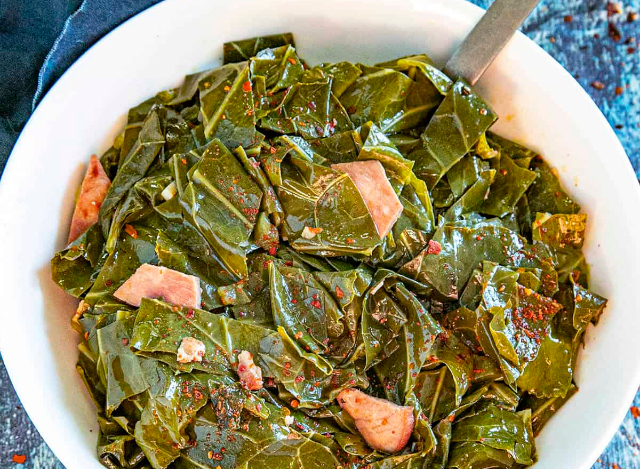I’ve just been through a rather nasty breakup with Kale. I’ve developed an aversion to the musty, metallic aspects of its flavour. Especially when it’s raw. But I’m told I can still get my iron from one of Kale’s cousins: Collard Greens…
 Classic Collards and Ham: No traditional southern Sunday dinner is without them!
Classic Collards and Ham: No traditional southern Sunday dinner is without them!
Granny got it right
Granny Clampett (see photo, top of page) had it right all along. Collard Greens are really good for you. In spite of the good-natured ribbing the leafy green has traditionally taken from ‘serious’ cooks and foodies.
In fact, says Adrienne Cheatham, they’re a superfood. Adrienne should know. She’s a James Beard-nominated chef, cookbook author and television personality.
“When I think of collard greens, I almost instinctively picture a steaming pot of long-simmered leaves, sliced into delicate ribbons or rolled into tight little bundles, swirling among pieces of smoked meat made tender by hours on the stove,” she relates. She’s a southern gal, and collards were always part of her family’s diet. Her granddad grew them in his back garden.
But Cheatham notes Collards also have a broader cultural significance. “There are few items as closely associated with a singular cuisine as collard greens are with the cuisine of Black Americans.”
Why are they a superfood?
Collards a member of a large and venerable family that includes kale, broccoli, cabbage, Brussels sprouts, and bok choy.
Like most dark green, leafy veggies, Collards pack a nutritional punch. According to an article from Tufts University, it’s a ‘fringe’ veggie that ‘deserves a second chance’. “[Collards] are an excellent source of vitamins C and K as well as dietary fiber. Collards also contain sulforaphane, which may help prevent some forms of cancer, and very large amounts of the carotenoid lutein, which concentrates in the brain and retina.”
How you cook ’em
You have to cook collards, no matter how you plan to serve them. Except, maybe, in salads. Cheatham says it definitely pays to select the youngest, most tender Collards you can get. Steer clear of the darker, larger leaves, which are usually tougher and more bitter. Basically, the same rule you’d use selecting spinach for a salad, rather than cooked presentations. Except that you should choose ‘baby’ collards for every application.
They take a long time to cook, especially the larger, darker leaves. Which are the kind you may have to settle for at the supermarket. Simmer them for an hour or more, until they lose their bitter edge and become fork tender. They’ll need a little salt. Add whatever you feel is appropriate. But do taste. That’s important.
Different cooks add different spices according to their family traditions, or as a result of their own experimentation. Cooked collards are almost always simmered with onions and/or garlic. Take note of the flavour enhancers called for in each recipe as you explore the thousands of preparations posted online.
Don’t dump the water!
They call that ‘pot likker’ down south. And it contains a host of nutrients leached from the collards during simmering. Some folks serve it along with the greens, in the same bowl. I’m going to try making a modest béchamel sauce. I think it will taste pretty good! And imagine the flavour when you’ve simmered the the greens with chunks of smoked ham, in the traditional southern manner!
Cheatham has a suggestion…
If you’re still skittish (as Granny would say!) about collards, Cheatham has a quick, easy, tasty salad recipe for you to try. The dressing features echoes of the Orient, and demonstrates beautifully what the right flavourings and spices can do to enhance the ‘collards experience’.
Go forth and Google those collards!
I’m off to my go-to produce source, Farm Boy, to hunt for tender, mild, young collard greens…
~ Maggie J.

